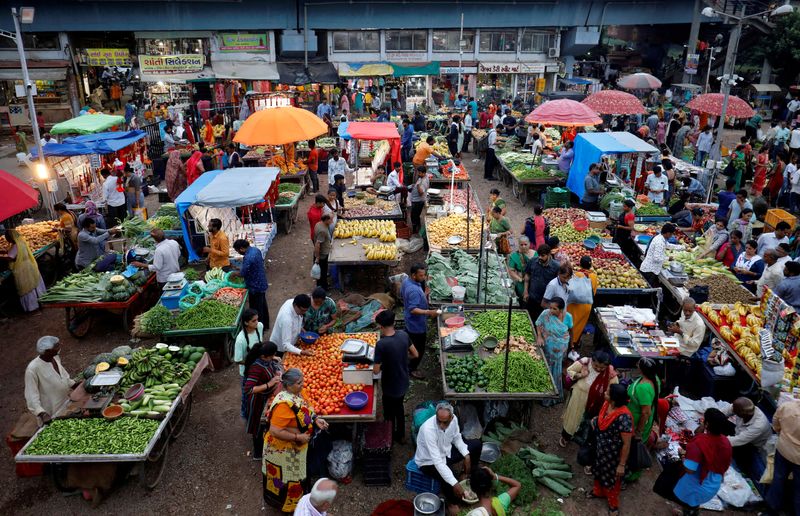
By Nikunj Ohri
NEW DELHI (Reuters) -India's retail inflation dropped to 1.55% in July, slipping below the central bank's comfort zone for the first time in eight years, as falling food prices, especially vegetables and pulses, squeezed the incomes of some farmers.
Annual retail inflation slowed to 1.55% in July as compared to 2.10% in June, and below a Reuters poll of 1.76%.
The figure was the lowest since June 2017, according to a government statement, and below the Reserve Bank of India's tolerance band of 2%-6%.
The RBI is mandated to keep inflation within a 2%–6% band and must explain to the government if it breaches either end for three consecutive quarters. While a drop below 2% signals weak demand and can hurt farm incomes and rural spending, it is unlikely to trigger an immediate rate cut as policymakers may view the decline as temporary and driven by volatile food prices.
"These inflation numbers are on expected lines," said Madan Sabnavis, chief economist at Bank of Baroda, adding that the impact on the RBI's policy decision will be muted.
The central bank lowered its inflation forecast for the current financial year to 3.1% from 3.7% earlier at its meeting earlier this month.
The RBI held key interest rates steady, saying the growth prospects of the domestic economy remained bright.
That was before U.S. President Donald Trump imposed an additional tariff of 25% on India - raising duties on goods to 50%, among the highest levied on U.S. trading partners.
The Indian government has estimated about 55% of the country's merchandise exports to the United States will be subject to the tariffs.
Some economists expect the low inflation and growth impact from tariffs to leave room for another rate cut.
"The RBI's already-lowered 12-month forecast may be undershot, raising the likelihood of further rate cuts, particularly as U.S. tariffs could shave 30–40 bps off GDP growth," said Sujan Hajra, chief economist at Anand Rathi Group in Mumbai.
Food prices have been the main driver for the drastic fall in inflation for the last eight months. Prices in July fell 1.76% compared to a revised fall of 1.01% in June.
Vegetable prices fell 20.69% compared with a 19% year-on-year drop in June, while prices of pulses declined 13.76% compared to a 12% fall in the previous month.
"While the softening food inflation is turning the terms of trade adversely for the farmers, higher real rural wages, good summer sowing, and the expected robust crop arrivals should offset the impact," said Upasna Bhardwaj, chief economist at Kotak Mahindra Bank.
On a month-on-month basis, vegetable prices rose although the cost of pulses continued to decline.
With the uptick in prices of some vegetables, such as tomatoes, India Ratings and Research expects retail inflation to swing up to 2.1% in August.
Core inflation, which excludes volatile items such as food and energy and is an indicator of domestic demand, was at 4%-4.12% in July versus 4.4%-4.5% in the previous month, according to two economists.
India's official statistics agency does not publish core inflation data.
(Reporting by Nikunj Ohri; Editing by Sonia Cheema)

 Reuters US Economy
Reuters US Economy
 America News
America News WISC-TV Channel 3000
WISC-TV Channel 3000 13 On Your Side
13 On Your Side Raw Story
Raw Story ABC News
ABC News Newsday
Newsday The Mercury News
The Mercury News Reuters US Top
Reuters US Top Post Register
Post Register